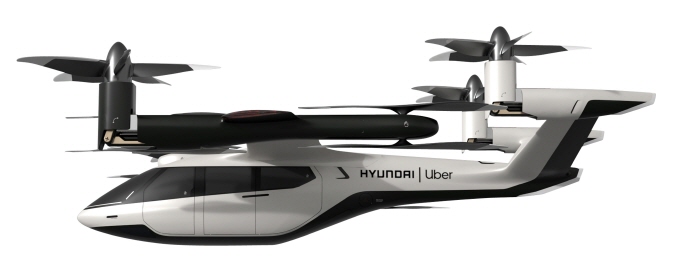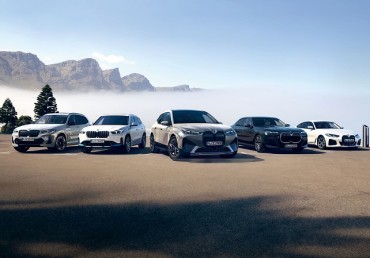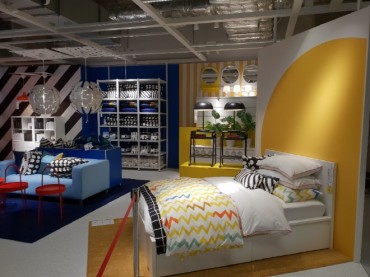
Hyundai Motor Group Executive Vice Chairman Chung Euisun (3rd L) poses for a photo with S-A1, a personal air vehicle concept jointly developed with the U.S. ride-hailing company Uber Technologies, during a media day event in Las Vegas on Jan. 6, 2020, the eve of the Consumer Electronics Show 2020. (Yonhap)
SEOUL, Jan. 7 (Korea Bizwire) — South Korea’s Hyundai Motor Co. on Tuesday unveiled its personal air vehicle (PAV) concept at the CES tech expo in Las Vegas to promote its smart mobility solutions.
Hyundai Motor partnered with U.S. ride-hailing company Uber Technologies Inc. to develop its first concept PAV named the S-A1 capable of electric vertical takeoff and landing (eVTOL), the company said in a statement.
The PAV will be operated initially by a pilot during the early stage of commercialization and driven autonomously once the relevant technologies are developed, it said.
“Hyundai is our first vehicle partner with experience of manufacturing passenger cars on a global scale. We believe Hyundai has the potential to build Uber Air vehicles at rates unseen in the current aerospace industry, producing high quality, reliable aircraft at high volumes to drive down passenger costs per trip,” said Eric Allison, head of Uber’s air taxi service named Uber Elevate.
He said combining Hyundai’s manufacturing muscle with Uber’s technology will help them take a big leap forward for launching a vibrant air taxi network in coming years.
The PAV represents the urban air mobility (UAM) service, one of three innovative mobility solutions sought by Hyundai Motor Group, along with purpose built vehicle (PBV) and Hub, a place for mobility transfer and community activities, the statement said.
UAM, a key future innovation business that can help overcome urban challenges like traffic congestion, connects the sky and the ground, while PBV allows passengers to enjoy tailored services while traveling to their destinations.
“We expect UAM will be commercialized in 2028, and the UAM services will be offered first in overseas markets,” Hyundai Motor Group Executive Vice Chairman Chung Euisun told reporters following a CES media day event held at Mandalay Bay Hotel in Las Vegas.
For the domestic launch of the services, Chung said the company will continue to consult with authorities to revise or ease relevant rules and regulations.
UAM will liberate people from gridlock and reclaim time for people to invest in activities they care about and enjoy.
And PBVs, upon personalization, can function as a restaurant, coffee shop, and hotel, or even a clinic and pharmacy, in addition to an urban shuttle, the statement said.
These two smart mobility solutions connect at the Hub, which will be installed across future cities to form a mobility ecosystem.
The Hub has a skyport for the PAV on the top and docking stations on the ground for the PBV to approach and depart from multiple directions, it said.
Hyundai showcased the smart mobility solutions highlighted by the lifesize PAV concept S-A1, the PBV concept S-Link and the Hub concept S-Hub at its exhibition booth at CES, which kicks off its four-day run Tuesday.

This photo provided by Hyundai Motor shows the S-A1, a personal air vehicle concept jointly developed with the U.S. ride-hailing company Uber Technologies.
The vision is in line with Hyundai Motor Group’s 2025 road map to transform itself into a “smart mobility solutions provider.”
The group plans to invest 100 trillion won in the next five years to strengthen its presence in the future mobility markets.
The groupwide investment plans include Hyundai Motor’s plan to inject 61 trillion won in its core automobile and future mobility businesses.
“For our smart mobility solutions, we considered what truly matters in cities and in people’s lives. UAM, PBV and Hub will revitalize cities by removing urban boundaries. Our goal is to help build dynamic human-centered future cities and continue our legacy of progress for humanity,” Hyundai Motor Group Executive Vice Chairman Chung Euisun said.
Meanwhile, Hyundai Mobis Co., an auto parts-making affiliate of the group, will promote its fully autonomous M.Vision S concept and a hydrogen fuel cell electric system for hydrogen-powered vehicles at the world’s biggest consumer technology-focused conference.
Hyundai Mobis introduced a Level 4 self-driving automation technology in its concept M.VISION at CES last year.
At Level 4, a vehicle can drive itself under limited conditions and will not operate if all required conditions are not satisfied. At Level 5, a vehicle’s automated driving features can drive under any conditions.
There are five levels of driving automation defined by the Society of Automotive Engineers International.
Hyundai Mobis has been conducting a motorway test of Level 3 technology in its M.BILLY autonomous car since 2018 in South Korea, the United States and Europe.
Since Level 3 cars are only good for limited self-driving, the driver must be available to take control of the car if the need arises.
A Level 3 car, if fully developed, will allow lane changes and other autonomous driving functions to work without intervention by the driver.
(Yonhap)






